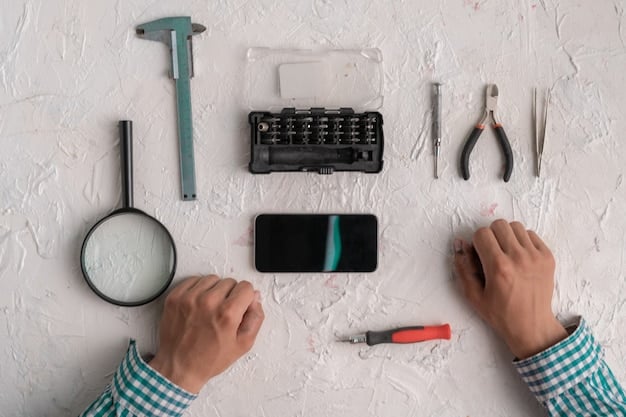Save $1000 a Year: Reduce Tech Reliance for Financial Freedom

Financial impact, how to save $1000 a year by reducing your reliance on tech gadgets can be achieved through simple lifestyle adjustments, such as opting for free entertainment, repairing devices, and utilizing community resources, ultimately leading to significant savings and a more mindful approach to technology.
In today’s digital age, it’s easy to become overly dependent on technology. But what if reducing your reliance on tech gadgets could significantly impact your finances? Let’s explore the financial impact: how to save $1000 a year by reducing your reliance on tech gadgets through simple, mindful changes.
Unplug and Prosper: The Financial Benefits of a Tech-Reduced Life
We often hear about the environmental and mental health benefits of reducing our screen time. However, the financial upsides are frequently overlooked. It’s time to shed light on how a deliberate step back from constant tech engagement can lead to substantial savings.
Beyond mere frugality, decreasing tech reliance encourages mindful spending, thoughtful choices, and a greater appreciation for non-digital alternatives. Let’s delve into practical strategies and real-life examples to demonstrate how this shift can positively impact your budget.

Cut Subscription Costs
One of the most significant areas for savings lies in reassessing your subscription services. Many of us subscribe to numerous streaming platforms, apps, and cloud storage solutions without fully utilizing them.
Take a close look at what you’re paying for and whether these subscriptions are truly adding value to your life. Don’t hesitate to cancel services you rarely use; those small monthly fees add up quickly.
- Identify Unused Subscriptions: Audit your monthly statements for recurring charges you don’t recognize or frequently use.
- Explore Free Alternatives: Many free streaming services, cloud storage options, and open-source software solutions can replace paid subscriptions.
- Share Subscriptions: Coordinate with family or friends to share accounts and split the costs of services you both enjoy.
By consciously managing and reducing your subscription footprint, you can easily save several hundred dollars each year, directly contributing to your $1000 savings goal.
Entertainment Without the Electronics
Modern entertainment often revolves around screens. But embracing non-digital sources of amusement can lead to unexpected financial relief. Moreover, it provides a refreshing break from the constant digital stimulation.
Explore the possibilities of free or low-cost alternatives that foster creativity, social connection, and a deeper engagement with the world around you. Reconnecting with these activities can enrich your life in ways that screens simply can’t.

Embrace Free Activities
Many communities offer a wealth of free events, resources, and spaces that can provide hours of entertainment without costing a dime. Exploring these opportunities can expand your horizons and introduce you to new passions.
Libraries, parks, and community centers are often treasure troves of free activities, from book clubs and concerts to fitness classes and workshops. Consider how these resources promote learning, wellness, and social interaction.
- Visit Local Libraries: Libraries offer free access to books, movies, music, and various community programs.
- Explore Parks and Trails: Spending time in nature is a great way to unwind and get exercise without spending money.
- Attend Free Community Events: Check local listings for free concerts, festivals, and workshops in your area.
By actively seeking out and participating in free, non-digital activities, you’ll not only save money, but also cultivate a more balanced and engaging lifestyle.
DIY Repairs and Reducing Device Turnover
Our relationship with technology often involves a cycle of frequent upgrades and replacements. However, extending the lifespan of your devices and embracing DIY repairs can significantly reduce your tech-related expenses.
Instead of rushing to buy the latest model, consider the environmental and financial benefits of repairing your existing devices. With the right tools and resources, many common issues can be fixed at home, saving you hundreds of dollars.
Extend Device Lifespan and Save
The key to curbing tech spending isn’t always about reducing usage, but rather maximizing the value and longevity of what you already own. This shift in mindset can have a profound impact on your budget and consumption habits.
Regular maintenance, careful handling, and strategic repairs can add years to the lifespan of your devices, delaying the need for costly replacements. This approach also aligns with sustainable practices, reducing electronic waste and promoting responsible consumption.
- Learn Basic Repair Skills: Online tutorials and workshops can teach you how to fix common issues with your devices.
- Use Protective Cases and Screen Protectors: These accessories can prevent damage and extend the life of your devices.
- Consider Refurbished Devices: Buying refurbished electronics can save you money while still getting a quality product.
By mastering a few simple repair techniques and being proactive about device maintenance, you can unlock substantial savings and reduce your contribution to the electronic waste stream.
Embrace Minimalism and Reduce Impulse Buys
The constant marketing of new tech gadgets can often lead to impulse purchases we later regret. Practicing minimalism and mindful shopping habits can help you resist these temptations and prioritize your spending.
Before making a tech purchase, take a moment to assess whether it’s truly necessary and whether it aligns with your financial goals. Often, you’ll find that existing devices and resources can adequately meet your needs.
Mindful Tech Consumption
The shift towards mindful tech consumption requires a conscious effort to break free from the allure of constant upgrades and the fear of missing out. It encourages you to evaluate your needs and desires critically, ensuring that your purchases are aligned with your values and financial stability.
By adopting a minimalist mindset and resisting the urge to acquire every new gadget, you’ll not only save money but also cultivate a more intentional and fulfilling relationship with technology.
- Wait Before Buying: Give yourself time to consider whether you really need a new tech gadget.
- Compare Prices: Research different retailers to find the best deals before making a purchase.
- Buy Only What You Need: Resist the urge to buy unnecessary accessories or upgrades.
Embracing minimalism will simplify your life and bring clarity to your finances. It promotes thoughtful spending and reduces the accumulation of unnecessary gadgets, freeing up your resources for more meaningful experiences.
Selling or Trading Unused Gadgets
Chances are, you have a drawer full of old phones, tablets, and other gadgets that are collecting dust. Monetizing these unused devices is a simple and effective way to recoup some of your tech investments.
Numerous online platforms and local stores offer options for selling or trading in your old tech, allowing you to turn your clutter into cash. Be sure to research the value of your devices and compare offers to get the best return.
Turning Old Tech into Cash
Transforming your unused gadgets into cash not only benefits your wallet but also contributes to responsible e-waste management. It’s a win-win situation that allows you to declutter your home while reducing your environmental footprint.
Whether you choose to sell online, trade-in at a retail store, or donate your devices to a charitable organization, each option provides an opportunity to give your old tech a new purpose and reap financial or social rewards.
- Research the Value of Your Gadgets: Use online tools to estimate the worth of your devices.
- Compare Offers from Different Buyers: Get quotes from multiple sources to find the best deal.
- Prepare Your Gadgets for Sale: Clean and reset your devices before selling or trading them in.
By proactively clearing out your tech clutter, you’ll not only gain extra cash but also create a more organized and clutter-free living space.
Utilizing Community Resources and Sharing
Many communities offer shared resources, such as tools, equipment, and workspaces, that can reduce the need to purchase individual tech gadgets. Exploring these options can foster resourcefulness and collaboration.
Consider libraries, makerspaces, and community centers that provide access to computers, printers, and other technologies. Sharing resources also promotes sustainability and reduces the overall demand for new devices.
Collaborative Consumption and Savings
The concept of collaborative consumption challenges the notion of individual ownership and promotes the sharing of resources for mutual benefit. By embracing this approach, you can access a wide range of tools and technologies without incurring the full cost of ownership.
Community-based initiatives, such as tool libraries and co-working spaces, provide affordable access to resources that would otherwise be out of reach for many individuals. Exploring these options connects you with like-minded individuals and strengthens the social fabric of your community.
- Join a Tool Library: Access a variety of tools and equipment for home repairs and DIY projects.
- Use Community Computers and Printers: Utilize public resources for your computing and printing needs.
- Share Tech Gadgets with Neighbors: Coordinate with neighbors to share infrequently used devices like projectors or scanners.
By actively participating in community resource sharing, you’ll not only reduce your tech expenses but also contribute to a more sustainable and collaborative society.
| Key Point | Brief Description |
|---|---|
| 📺 Cut Subscriptions | Cancel unused streaming and app subscriptions to save money. |
| 📚 Free Entertainment | Utilize libraries and community events for free entertainment options. |
| 🛠️ DIY Repairs | Extend device lifespans by learning basic repair skills. |
| 🤝 Share Resources | Share tech gadgets and resources with neighbors and community. |
Frequently Asked Questions (FAQ)
▼
Review your monthly bank or credit card statements for recurring charges. Identify services you haven’t used in the past few months and consider canceling them.
▼
Explore free ad-supported streaming platforms, local library services offering movies and music, or borrow content from friends and family to reduce subscription costs.
▼
Online resources like iFixit and YouTube offer tutorials. Local community centers or makerspaces may also host workshops on device repair.
▼
Check local community bulletin boards, libraries, and online event calendars. Many towns offer free concerts, festivals, and workshops throughout the year.
▼
Sell or trade them in at electronics stores or online marketplaces. Donate them to charities or schools. Recycle them at designated e-waste collection sites to protect the environment.
Conclusion
Reducing your reliance on tech gadgets can not only save you money but also promote a more mindful and balanced lifestyle. By cutting unnecessary subscriptions, exploring free entertainment options, embracing DIY repairs, and utilizing community resources, you can easily save $1000 a year and cultivate a healthier relationship with technology.





